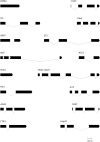Genomic Mining of Phylogenetically Informative Nuclear Markers in Bark and Ambrosia Beetles
- PMID: 27668729
- PMCID: PMC5036811
- DOI: 10.1371/journal.pone.0163529
Genomic Mining of Phylogenetically Informative Nuclear Markers in Bark and Ambrosia Beetles
Abstract
Deep level insect relationships are generally difficult to resolve, especially within taxa of the most diverse and species rich holometabolous orders. In beetles, the major diversity occurs in the Phytophaga, including charismatic groups such as leaf beetles, longhorn beetles and weevils. Bark and ambrosia beetles are wood boring weevils that contribute 12 percent of the diversity encountered in Curculionidae, one of the largest families of beetles with more than 50000 described species. Phylogenetic resolution in groups of Cretaceous age has proven particularly difficult and requires large quantity of data. In this study, we investigated 100 nuclear genes in order to select a number of markers with low evolutionary rates and high phylogenetic signal. A PCR screening using degenerate primers was applied to 26 different weevil species. We obtained sequences from 57 of the 100 targeted genes. Sequences from each nuclear marker were aligned and examined for detecting multiple copies, pseudogenes and introns. Phylogenetic informativeness (PI) and the capacity for reconstruction of previously established phylogenetic relationships were used as proxies for selecting a subset of the 57 amplified genes. Finally, we selected 16 markers suitable for large-scale phylogenetics of Scolytinae and related weevil taxa.
Conflict of interest statement
The authors have declared that no competing interests exist.
Figures





References
-
- Maddison DR, Moore W, Baker MD, Ellis TM, Ober KA, Cannone JJ, et al. Monophyly of terrestrial adephagan beetles as indicated by three nuclear genes (Coleoptera: Carabidae and Trachypachidae). Zool Scr. 2009; 38(1): 43–62. Epub 2009/10/01. 10.1111/j.1463-6409.2008.00359.x ; PubMed Central PMCID: PMCPmc2752903. - DOI - PMC - PubMed
-
- Shull VL, Vogler AP, Baker MD, Maddison DR, Hammond PM. Sequence alignment of 18S ribosomal RNA and the basal relationships of Adephagan beetles: evidence for monophyly of aquatic families and the placement of Trachypachidae. Syst Biol. 2001; 50(6): 945–969. Epub 2002/07/16. . - PubMed
LinkOut - more resources
Full Text Sources
Other Literature Sources
Research Materials
Miscellaneous

